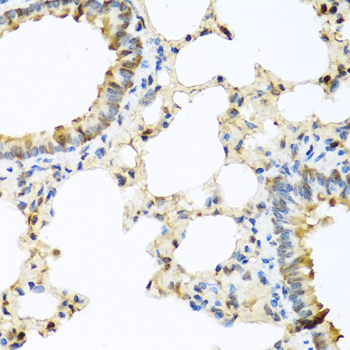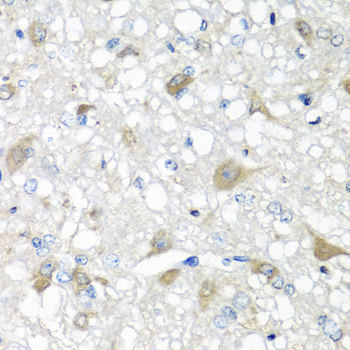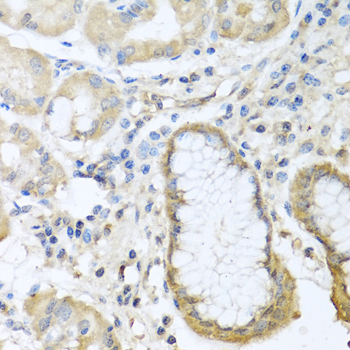Cell Biology Antibodies 11
Anti-CCL11 Antibody (CAB7569)
- SKU:
- CAB7569
- Product Type:
- Antibody
- Reactivity:
- Human
- Reactivity:
- Mouse
- Reactivity:
- Rat
- Host Species:
- Rabbit
- Isotype:
- IgG
- Antibody Type:
- Polyclonal Antibody
- Research Area:
- Cell Biology
Description
| Antibody Name: | Anti-CCL11 Antibody |
| Antibody SKU: | CAB7569 |
| Antibody Size: | 20uL, 50uL, 100uL |
| Application: | WB IHC IF |
| Reactivity: | Human, Mouse, Rat |
| Host Species: | Rabbit |
| Immunogen: | Recombinant fusion protein containing a sequence corresponding to amino acids 1-97 of human CCL11 (NP_002977.1). |
| Application: | WB IHC IF |
| Recommended Dilution: | WB 1:500 - 1:2000 IHC 1:50 - 1:100 IF 1:50 - 1:100 |
| Reactivity: | Human, Mouse, Rat |
| Positive Samples: | A-549, 293T, Mouse skeletal muscle |
| Immunogen: | Recombinant fusion protein containing a sequence corresponding to amino acids 1-97 of human CCL11 (NP_002977.1). |
| Purification Method: | Affinity purification |
| Storage Buffer: | Store at -20'C. Avoid freeze / thaw cycles. Buffer: PBS with 0.02% sodium azide, 50% glycerol, pH7.3. |
| Isotype: | IgG |
| Sequence: | MKVS AALL WLLL IAAA FSPQ GLAG PASV PTTC CFNL ANRK IPLQ RLES YRRI TSGK CPQK AVIF KTKL AKDI CADP KKKW VQDS MKYL DQKS PTPK P |
| Gene ID: | 6356 |
| Uniprot: | P51671 |
| Cellular Location: | Secreted |
| Calculated MW: | 10kDa |
| Observed MW: | 20kDa |
| Synonyms: | CCL11, SCYA11, eotaxin |
| Background: | This antimicrobial gene is one of several chemokine genes clustered on the q-arm of chromosome 17. Chemokines form a superfamily of secreted proteins involved in immunoregulatory and inflammatory processes. The superfamily is divided into four subfamilies based on the arrangement of the N-terminal cysteine residues of the mature peptide. This chemokine, a member of the CC subfamily, displays chemotactic activity for eosinophils, but not mononuclear cells or neutrophils. This eosinophil-specific chemokine is thought to be involved in eosinophilic inflammatory diseases such as atopic dermatitis, allergic rhinitis, asthma and parasitic infections. |
| UniProt Protein Function: | CCL11: In response to the presence of allergens, this protein directly promotes the accumulation of eosinophils, a prominent feature of allergic inflammatory reactions. Binds to CCR3. Belongs to the intercrine beta (chemokine CC) family. |
| UniProt Protein Details: | Protein type:Motility/polarity/chemotaxis; Secreted, signal peptide; Secreted Chromosomal Location of Human Ortholog: 17q12 Cellular Component: extracellular region; extracellular space; intracellular Molecular Function:CCR chemokine receptor binding; chemokine activity; protein binding Biological Process: actin filament organization; cell adhesion; cellular calcium ion homeostasis; chemotaxis; chronic inflammatory response; cytoskeleton organization and biogenesis; eosinophil chemotaxis; G-protein coupled receptor protein signaling pathway; inflammatory response; lymphocyte chemotaxis; mast cell chemotaxis; monocyte chemotaxis; neutrophil chemotaxis; positive regulation of actin filament polymerization; positive regulation of angiogenesis; positive regulation of cell migration; positive regulation of endothelial cell proliferation; positive regulation of GTPase activity; positive regulation of inflammatory response; protein amino acid phosphorylation; regulation of cell shape; response to radiation; response to virus; signal transduction Disease: Asthma, Susceptibility To; Human Immunodeficiency Virus Type 1, Susceptibility To |
| NCBI Summary: | This antimicrobial gene is one of several chemokine genes clustered on the q-arm of chromosome 17. Chemokines form a superfamily of secreted proteins involved in immunoregulatory and inflammatory processes. The superfamily is divided into four subfamilies based on the arrangement of the N-terminal cysteine residues of the mature peptide. This chemokine, a member of the CC subfamily, displays chemotactic activity for eosinophils, but not mononuclear cells or neutrophils. This eosinophil-specific chemokine is thought to be involved in eosinophilic inflammatory diseases such as atopic dermatitis, allergic rhinitis, asthma and parasitic infections. [provided by RefSeq, Sep 2014] |
| UniProt Code: | P51671 |
| NCBI GenInfo Identifier: | 1706661 |
| NCBI Gene ID: | 6356 |
| NCBI Accession: | P51671.1 |
| UniProt Secondary Accession: | P51671,P50877, Q92490, Q92491, |
| UniProt Related Accession: | P51671 |
| Molecular Weight: | 10,732 Da |
| NCBI Full Name: | Eotaxin |
| NCBI Synonym Full Names: | C-C motif chemokine ligand 11 |
| NCBI Official Symbol: | CCL11 |
| NCBI Official Synonym Symbols: | SCYA11 |
| NCBI Protein Information: | eotaxin |
| UniProt Protein Name: | Eotaxin |
| UniProt Synonym Protein Names: | C-C motif chemokine 11; Eosinophil chemotactic protein; Small-inducible cytokine A11 |
| Protein Family: | Eotaxin |
| UniProt Gene Name: | CCL11 |
| UniProt Entry Name: | CCL11_HUMAN |











